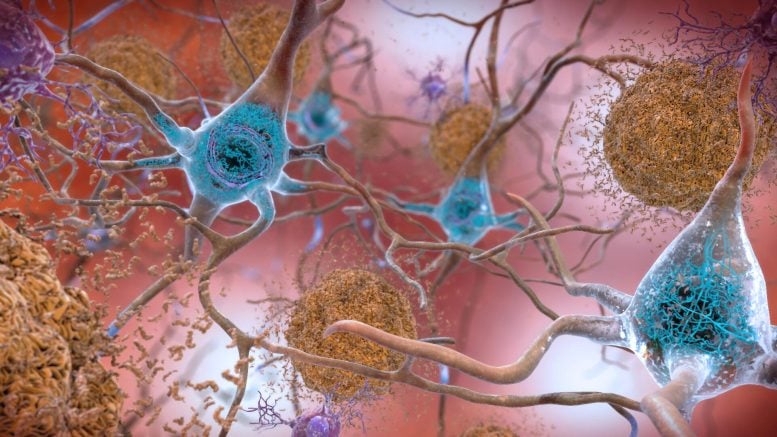博文
阿尔茨海默氏症的真正原因可能不是淀粉样蛋白:突破性的发现挑战几十年的理论
 精选
精选
||
阿尔茨海默氏症的真正原因可能不是淀粉样蛋白:突破性的发现挑战几十年的理论
诸平
据“埃默里健康科学”(Emory Health Sciences)2024年8月15日提供的消息,阿尔茨海默氏症的真正原因可能不是淀粉样蛋白:突破性的发现挑战了几十年的理论(The Real Cause of Alzheimer’s Might Not Be Amyloid: Groundbreaking Discovery Challenges Decades-Old Theories)。
埃默里大学(Emory University)的一项新研究表明,b-淀粉样蛋白沉积物周围积聚的蛋白质,而不是沉积物本身,可能在阿尔茨海默病(Alzheimer’s disease)的进展中起着至关重要的作用,为治疗提供了新的方向。
美国埃默里大学(Emory University, Atlanta, GA, USA)最近的研究,促使人们重新评估目前有关阿尔茨海默病(Alzheimer’s disease)起源的理论。阿尔茨海默病是全球痴呆症的主要病因。在埃默里大学医学院戈伊苏埃塔大脑健康研究所(Goizueta Brain Health Institute and Alzheimer's Disease Research Center, Emory University School of Medicine, Atlanta, GA, USA)的科学家们的带领下,研究小组发现了令人信服的证据,表明阿尔茨海默氏症可能有一种不同的机制。相关研究结果于2024年8月2日已经在《细胞报告医学》(Cell Reports Medicine)杂志网站在线发表——Yona Levites, Eric B. Dammer, Yong Ran, Wangchen Tsering, Duc Duong, Measho Abreha, Joshna Gadhavi, Kiara Lolo, Jorge Trejo-Lopez, Jennifer Phillips, Andrea Iturbe, Aya Erquizi, Brenda D. Moore, Danny Ryu, Aditya Natu, Kristy Dillon, Jose Torrellas, Corey Moran, Thomas Ladd, Farhana Afroz, Tariful Islam, Jaishree Jagirdar, Cory C. Funk, Max Robinson, Srikant Rangaraju, David R. Borchelt, Nilüfer Ertekin-Taner, Jeffrey W. Kelly, Frank L. Heppner, Erik C.B. Johnson, Karen McFarland, Allan I. Levey, Stefan Prokop, Nicholas T. Seyfried, Todd E. Golde. Integrative proteomics identifies a conserved Aβ amyloid responsome, novel plaque proteins, and pathology modifiers in Alzheimer’s disease. Cell Reports Medicine, 2024 Aug 2: 101669. DOI: 10.1016/j.xcrm.2024.101669.
参与此项研究的除了来自美国埃默里大学的研究人员之外,还有来自美国佛罗里达大学(University of Florida, Gainesville, FL, USA)、美国埃默里大学医院(Emory University Hospital, Atlanta, GA, USA)、美国西雅图系统生物学研究所(Institute for Systems Biology, Seattle, WA, USA)、美国耶鲁大学(Yale University, New Haven, CT, USA)、美国杰克逊维尔市的梅奥诊所(Mayo Clinic, Jacksonville, FL, USA)、美国斯克里普斯研究所(The Scripps Research Institute, La Jolla, CA, USA)、德国柏林自由大学和德国柏林的洪堡大学合办的德国柏林大学差瑞特医学院(Charité - Universitätsmedizin Berlin, Corporate Member of Freie Universität Berlin and Humboldt-Universität zu Berlin, Berlin, Germany)、德国柏林的德国神经退行性疾病中心{German Center for Neurodegenerative Diseases (DZNE) Berlin, Berlin, Germany}以及德国柏林的神经治疗卓越集群(Cluster of Excellence, NeuroCure, Charitéplatz, Berlin, Germany)的研究人员。
托德·戈尔德(Todd E. Golde)和约娜·列维捷斯(Yona Levites)等人在《细胞报告医学》(Cell Reports Medicine)杂志上发表的此篇论文中,解释了长期以来在阿尔茨海默病患者大脑中积累的淀粉样蛋白是如何成为其他蛋白质积累的一种支架的。由于这些蛋白质中有许多具有已知的信号功能,它们在淀粉样蛋白堆积(即斑块)周围的存在可能是导致脑细胞损伤的罪魁祸首,而不是淀粉样蛋白本身。
在阿尔茨海默症患者的大脑中,淀粉样蛋白积累并形成粘性斑块,从而破坏大脑功能并导致认知能力下降。最大的未知是这究竟是如何发生的。根据最广泛接受的假设,淀粉样蛋白的积累破坏了细胞间的交流,激活了免疫细胞,最终破坏了脑细胞。
来自先进研究技术的见解(Insights from Advanced Research Techniques)
在此项研究中,埃默里大学医学院戈伊祖塔研究所埃默里神经退行性疾病中心(Emory Center for Neurodegenerative Disease in the Goizueta Institute)主任托德·戈尔德和埃默里大学医学院(Emory University’s School of Medicine)副教授约娜·列维捷斯等人提出了一种新的假设,强调了b淀粉样蛋白的不同作用。b淀粉样蛋白是一种在所有大脑中形成的简单蛋白质,但通常会通过自然过程溶解。
在实验中,他们利用尖端的分析技术,鉴定并测量了阿尔茨海默氏症患者大脑中8000多种蛋白质的含量,以及老鼠大脑中类似蛋白质的含量。他们把注意力集中在那些水平急剧上升的蛋白质上,在阿尔茨海默氏症患者和老鼠的大脑中发现了20多种与淀粉样蛋白共同积累的蛋白质。随着研究的继续,他们怀疑他们会发现更多。
新治疗方法的潜力(Potential for New Therapeutic Approaches)
托德·戈尔德说:“一旦我们确定了这些新的蛋白质,我们想知道它们是否仅仅是阿尔茨海默氏症的标志,还是它们实际上可以改变这种疾病的致命病理。”为了回答这个问题,我们集中研究了两种蛋白质,中期因子(midkine)和多效生长因子(pleiotrophin)。我们的研究表明,它们在试管和小鼠体内都加速了淀粉样蛋白的聚集。换句话说,这些额外的蛋白质可能在导致脑损伤的过程中发挥重要作用,而不是淀粉样蛋白本身。这表明它们可能是治疗这种可怕的大脑疾病的新疗法的基础,这种疾病多年来一直令人沮丧地抵抗治疗。”
虽然人们对阿尔茨海默氏症的基本原理已经有了一个多世纪的了解,但寻找治疗方法的过程一直很缓慢,通常是一开始有希望的治疗方法在试验中不起作用的反复循环,以及在解释这种疾病如何损害大脑的相互竞争的理论上持续存在争议。正如研究人员所说,“最初的纯线性淀粉样蛋白级联的概念现在被认为是过于简单化了。随着阿尔茨海默病的出现,许多项研究揭示了几十年来个体大脑发生的巨大复杂变化。”
值得注意的是,除了β淀粉样蛋白外,多种淀粉样蛋白的形成与30多种影响全身组织和器官的人类疾病有关。由于这项新研究提出了阿尔茨海默病发展的新过程,它可能为发现其他疾病的治疗靶点提供新的方法。
这项研究得到了美国国立卫生研究院(National Institutes of Health)的部分支持。
上述介绍,仅供参考。欲了解更多信息,敬请注意浏览原文或者相关报道。
New findings suggest alternative mechanisms behind Alzheimer's disease
Alzheimer's disease (AD) is a complex neurodegenerative disorder that develops over decades. AD brain proteomics reveals vast alterations in protein levels and numerous altered biologic pathways. Here, we compare AD brain proteome and network changes with the brain proteomes of amyloid β (Aβ)-depositing mice to identify conserved and divergent protein networks with the conserved networks identifying an Aβ amyloid responsome. Proteins in the most conserved network (M42) accumulate in plaques, cerebrovascular amyloid (CAA), and/or dystrophic neuronal processes, and overexpression of two M42 proteins, midkine (Mdk) and pleiotrophin (PTN), increases the accumulation of Aβ in plaques and CAA. M42 proteins bind amyloid fibrils in vitro, and MDK and PTN co-accumulate with cardiac transthyretin amyloid. M42 proteins appear intimately linked to amyloid deposition and can regulate amyloid deposition, suggesting that they are pathology modifiers and thus putative therapeutic targets. We posit that amyloid-scaffolded accumulation of numerous M42+ proteins is a central mechanism mediating downstream pathophysiology in AD.
https://blog.sciencenet.cn/blog-212210-1447269.html
上一篇:原子控制开启单分子光电子学新时代
下一篇:创新化合物利用新机制杀死癌细胞
